Star Wars Small-Arms
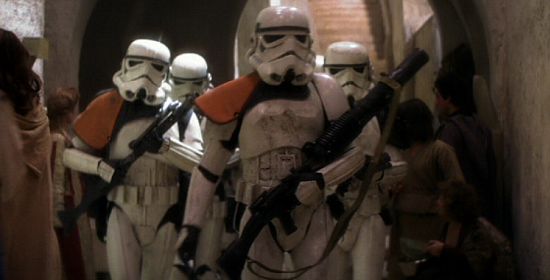
Imperial
stormtroopers carrying infantry weapons (the foreground trooper
appears to be
carrying something like a LMG and the one behind him
seems to have an assault rifle)
The guns of the Empire are similar to those of modern armies in terms of both usage and appearance. Like modern guns, they generally feature a cylindrical barrel extending past the main body. They feature a handle and trigger group virtually identical to modern firearms. Most of them feature telescopic sights, although fixed sights are usually present as well. They are metallic, and usually black. The long guns feature solid stocks like those of modern assault rifles and machine guns, while the intermediate-sized guns feature folding stocks, much like those of modern sub-machine guns. Handguns are worn in hip or thigh holsters. Heavy machine guns are mounted on tripods. The sheer variety also mirrors real life: unlike the Federation, they have not restricted themselves to just two or three gun designs.
This makes sense in light of the fact that these weapons don't fire physical projectiles. In real armies, the desire for standardization and reduced variety of weapons is largely due to logistics. It's cheaper and easier to supply an army which has just one gun design instead of three, five, or ten (hence the popularity of the assault rifle, which was originally a compromise between two weapon classes). The desire for standardization is even greater when dealing with the ammunition for the guns as opposed to the guns themselves, since it's easier to supply just one cartridge as opposed to a series of different calibres. However, when the need for physical bullets is removed, the incentive for standardization diminishes. It then becomes more logical to have a wide variety of weapons, each highly specialized for its chosen application.
Handguns
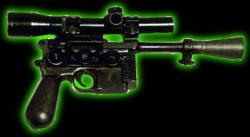 This
category is represented by numerous weapons seen throughout the canon
films, such as the Tantive IV crew's Blastech DH-17 pistols in ANH,
Han Solo's big Blastech DL-44 (which Luke also carried into Bespin,
albeit without the scope), Greedo's blaster, various duelling
pistols, the scout troopers' handguns in ROTJ, Jawa ionization
pistols for use against droids, disruptor pistols, sonic pistols,
tiny dart guns, flechette pistols, the handguns carried by Jabba's
skiff crews, the sleek silver handguns used by some of the Naboo, and
the heavier Naboo handguns with the Bat-cable attachment. In all of
these cases, the application for the weapon is identical to that of
modern handguns: infrequent, low-intensity close-quarters combat. The
rebels in ANH were the lightly armed crew of a diplomatic vessel, and
they were obviously not prepared to fight a pitched battle. Han Solo
and Greedo are small-time criminals. Luke Skywalker carried the
sidearm of a pilot, which is invariably a handgun in modern air
forces. Scout troopers are obviously scouts rather than infantrymen.
Jabba's men were mere criminals. The Naboo were police officers and
palace guards (the Naboo have no standing army).
This
category is represented by numerous weapons seen throughout the canon
films, such as the Tantive IV crew's Blastech DH-17 pistols in ANH,
Han Solo's big Blastech DL-44 (which Luke also carried into Bespin,
albeit without the scope), Greedo's blaster, various duelling
pistols, the scout troopers' handguns in ROTJ, Jawa ionization
pistols for use against droids, disruptor pistols, sonic pistols,
tiny dart guns, flechette pistols, the handguns carried by Jabba's
skiff crews, the sleek silver handguns used by some of the Naboo, and
the heavier Naboo handguns with the Bat-cable attachment. In all of
these cases, the application for the weapon is identical to that of
modern handguns: infrequent, low-intensity close-quarters combat. The
rebels in ANH were the lightly armed crew of a diplomatic vessel, and
they were obviously not prepared to fight a pitched battle. Han Solo
and Greedo are small-time criminals. Luke Skywalker carried the
sidearm of a pilot, which is invariably a handgun in modern air
forces. Scout troopers are obviously scouts rather than infantrymen.
Jabba's men were mere criminals. The Naboo were police officers and
palace guards (the Naboo have no standing army).
The range and accuracy of a Star Wars handgun is unknown, but ergonomic considerations limit the accuracy of a handgun in the hands of the average human being irrespective of its theoretical capabilities. Handguns have been used effectively at ranges of 10-15 metres in the films, thus establishing that their effective range is at least as long as that of modern handguns. An unanswered question is the ammunition capacity of a Star Wars handgun. During the protracted battle of Naboo, we never saw anyone pause to reload once, which suggests that the heavy Naboo handguns can fire at least a few dozen shots before reloading. It is unfortunate that we never see the reloading procedure, because it would be interesting to compare the ergonomics of this process to that of modern handguns.
The penetrating power of a Star Wars handgun probably varies greatly from design to design, much like the power of modern handguns. Han Solo's blaster is quite large, and was seen blasting torso-sized chunks out of the docking bay walls in the Mos Eisley getaway scene as seen below. This gives it knock-down power more like a grenade launcher than a handgun, and it makes sense in light of its owner. Unlike a professional soldier, Han Solo is a man who expects to get into a gunfight against very limited odds, most likely in the form of a "mano a mano" showdown. The fact that he filed off his iron sights to facilitate the quick-draw (as described in "Han Solo at Star's End") supports this speculation, since that is the sort of act which is virtually incomprehensible for anyone who expects to get into any other kind of combat. Therefore, he packs a gun which sacrifices ammunition for sheer killing power, so that even the most superficial glancing hit is virtually guaranteed to be lethal.
A real-life analogy would be the target-shooter, criminal, guerilla, or gun enthusiast who carries a huge handgun like the .44 Magnum Desert Eagle. Enormous cartridges like this are really much too powerful for military or police use, since their size and power come at a cost in ammunition capacity, and military and police use may require simultaneous engagement of multiple enemies, thus making ammunition capacity more important. Therefore, guns like this are not used by military forces and police officers (except for Dirty Harry, of course), but they are popular with many other types of gun owner, and there is a certain glamourous cachet about carrying one of the most powerful handguns in the world.
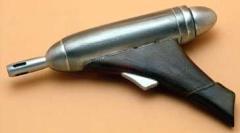 The
tiny handguns used by Queen Amidala and her handmaidens were much
less powerful than Han Solo's weapon, but they still had enough
firepower to knock the Neimoidian battle droids off their feet and
put them down permanently. The lack of sights or scopies or any other
protrusions indicates that they were designed for concealment and
extreme close-quarters use, as demonstrated by the fact that they
were invariably hidden from view, either on the persons of Queen
Amidala's handmaidens or inside the armrest of her throne. Weapons
like this are analogous to modern "holdout weapons" and
would presumably have a very limited number of shots, for the purpose
of holding off an enemy until help can arrive rather than engaging in
full-fledged combat. As with Han Solo's gun, a gun like this will be
designed for excessive firepower since it is crucial to ensure that
each shot counts.
The
tiny handguns used by Queen Amidala and her handmaidens were much
less powerful than Han Solo's weapon, but they still had enough
firepower to knock the Neimoidian battle droids off their feet and
put them down permanently. The lack of sights or scopies or any other
protrusions indicates that they were designed for concealment and
extreme close-quarters use, as demonstrated by the fact that they
were invariably hidden from view, either on the persons of Queen
Amidala's handmaidens or inside the armrest of her throne. Weapons
like this are analogous to modern "holdout weapons" and
would presumably have a very limited number of shots, for the purpose
of holding off an enemy until help can arrive rather than engaging in
full-fledged combat. As with Han Solo's gun, a gun like this will be
designed for excessive firepower since it is crucial to ensure that
each shot counts.
An even more extreme example of this design philosophy is found in the Tenloss DX-2 Disruptor Pistol and DXR-6 Disruptor Rifle. An examination of the picture will reveal that both weapons are meant for extreme short range use, since even the "rifle" is no longer than a modern SMG and has no shoulder stock. The SWEGWT supports this speculation by stating that their ranges are just 7 metres and 20 metres. Ammunition capacity is also poor; both guns can fire just five shots before reloading. However, these guns are so powerful that even a single shot from the weaker pistol can disintegrate ½ m³ of durasteel armour plate! This makes them much more destructive than the normal handguns of the Empire (or the Federation), which can easily blast through rock or masonry but are ineffective against armour. The operating mechanism is actually no different than that of normal blasters; according to the SWEGWT, the only real difference is that it can "process a much greater volume of blaster gas" with each shot, thus indicating that as expected, it deliberately trades ammunition capacity for destructive power (it also means that 20 shots from a regular Blastech E-11 would have the same effect as one shot from the Disruptor).
At the other end of the spectrum from these specialized weapons, Captain Panaka's Security S-5 military handgun resembled a modern general purpose handgun, designed for a wide variety of functions appropriate for police use. According to the Episode 1 Visual Dictionary, it had a rangefinding scope, an under-slung stun dart launcher, a stun setting, and a grappling hook attachment with a retractable liquid cable. It was powerful enough to put down a battle droid without being capable of reducing them to debris the way Han Solo's gun would have, and he was able to fire a great many shots without having to reload. He was also able to blast a large hole in a nearby window without injuring nearby friendlies, which suggests the use of low-powered shots (or perhaps dual power settings, since it was still powerful enough to dismember metallic battle droids). Similarly, the scout trooper handguns in ROTJ were not particularly destructive, although they were undoubtedly powerful enough to kill, thus indicating that they probably compromised firepower for the sake of miniaturization and ammunition capacity. As with real-life handguns, there is undoubtedly a Imperial manufacturer of handguns to suit every purpose, from enthusiasts to criminals, bodyguards, and soldiers.
Sub-machine Guns and Carbines
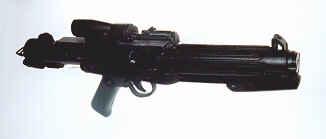 The
categories of SMGs and carbines blur together in the world of sci-fi,
because the principal distinction between SMGs and carbines (the type
of cartridge) has no meaning when applied to guns which don't fire
physical bullets. The resulting shared category is most popularly
represented by the Blastech E-11 blaster rifle, which is the most
common stormtrooper sidearm in the films. Another example would be
Boba Fett's carbine. The Blastech E-11 bears a striking resemblance
to the British Sterling SMG of decades past, its size is appropriate
for an SMG and its folding stock has been a staple feature of SMGs
for decades. It is usually equipped with a scope, which is
reminiscent of modern SMGs such as the Heckler & Koch MP5, which
is issued to police SWAT teams, Army Special Ops, and anti-terrorist
specialists around the world. The Blastech E-11, like the MP5 and the
lookalike HK53 carbine, is often found with a scope attachment in
addition to iron sights (notice the raised fore and rear sights in
the accompanying picture), which are presumably used if the scope is
removed, damaged, or knocked out of alignment (it looks like the
topside accessory rail has a V-groove running through it so that you
can use the sights without having to remove the rail).
The
categories of SMGs and carbines blur together in the world of sci-fi,
because the principal distinction between SMGs and carbines (the type
of cartridge) has no meaning when applied to guns which don't fire
physical bullets. The resulting shared category is most popularly
represented by the Blastech E-11 blaster rifle, which is the most
common stormtrooper sidearm in the films. Another example would be
Boba Fett's carbine. The Blastech E-11 bears a striking resemblance
to the British Sterling SMG of decades past, its size is appropriate
for an SMG and its folding stock has been a staple feature of SMGs
for decades. It is usually equipped with a scope, which is
reminiscent of modern SMGs such as the Heckler & Koch MP5, which
is issued to police SWAT teams, Army Special Ops, and anti-terrorist
specialists around the world. The Blastech E-11, like the MP5 and the
lookalike HK53 carbine, is often found with a scope attachment in
addition to iron sights (notice the raised fore and rear sights in
the accompanying picture), which are presumably used if the scope is
removed, damaged, or knocked out of alignment (it looks like the
topside accessory rail has a V-groove running through it so that you
can use the sights without having to remove the rail).
The appearance of the scope is interesting. Its position and size suggest that it would be uncomfortable to press your eye close to it, and indeed, we never seem to see anyone doing so in the films. Moreover, a stormtrooper's bulky helmet would make that task virtually impossible, so it seems likely that it isn't meant to be used in that manner. To make things more interesting, the SWEGWT describes it as a "powered scope", which suggests that it must be something more than a simple telescopic device. However, since a stormtrooper helmet already contains imaging systems (click here to see a helmet cutaway), it seems pointless to have night-sight or infrared imaging systems built into the scope of his gun. Perhaps it is an optical sight, but it requires power in order to transmit its image directly to the stormtrooper's built-in helmet imaging systems. Another possibility is that it is a visual scope with viewer illumination so that it is always much brighter than its backdrop, and it can be used with both eyes open. "Both-eyes-open" aiming is ergonomically more natural, and real-life powered-scope systems such as the Trijicon ACOG Reflex system use illumination for precisely that reason. It allows a scope to be useful in both long-range sniping and short-range close-quarters combat situations. The third, and perhaps most likely explanation is a combination of both: it transmits an image to the stormtrooper's helmet imaging systems via extreme short-range low-powered wireless communications, but since this could potentially be jammed by high-powered ECM on the battlefield, it can also be used as an illuminated optical scope. For a well trained stormtrooper, it would undoubtedly be second nature to switch to optical in the event of a communications problem. This would also allow the weapon to be used by troopers whose helmets are damaged and/or malfunctioning, and by other types of personnel who don't wear stormtrooper armour.
Although the Blastech E11 invariably has a scope in the films, the existence of iron sights suggests that it may be an optional component. The fact that we don't see them without the scope doesn't necessarily contradict this speculation, since it remains a possibility that troops elsewhere don't use scopes (in real life, the British army issues assault rifles with telescopic sights to its front-line troops and assault rifles with iron sights to its rear-echelon troops). In particular, Blastech E11s which are issued to troops other than stormtroopers may routinely be shipped without scopes.
In the canon films, these blasters were mostly used in semi-automatic mode, although rapid-fire two-shot bursts were seen twice in ANH: once during the TK-421 scene when Han Solo broke into the control room and fired two shots 1/6 seconds apart, and once during the Detention Centre break-in when Chewbacca fired two shots up at a wall-mounted laser trap, again roughly 1/6 seconds apart. Since that is too fast for semi-automatic fire, this indicates the existence of a two-shot burst mode with a 360 rpm firing rate, analogous to the three-shot burst mode available on real automatic weapons. The three-shot burst on a real assault rifle is designed to defeat body armour; contrary to popular belief, its primary purpose is not to conserve ammunition (competent soldiers are taught to do that for themselves, and they should already know that fully automatic fire is only used for rapidly clearing out confined spaces such as bunkers, trenches, and rooms). The bullets emerge so quickly that the third bullet is out of the barrel before the recoil from the first shot throws the gun noticeably off-axis, so the net effect is that all three shots hit in a very small grouping, thus increasing their chances of penetration. The two-shot burst would be similar; the first shot damages the armour and the second shot blasts through the resulting weak spot. This setting is probably intended for use against armoured battle droids and similarly difficult targets, and it would not be necessary against un-armoured humans. Therefore, Han Solo's use of this mode was probably unintentional.
In any case, there is no reason to imagine that as an "energy weapon", the Blastech E11 wouldn't be capable of fully automatic fire in addition to the established semi-automatic and two-shot burst modes. Remember that the lack of automatic fire in modern firearms is actually due to their particular physical mechanism: they need your trigger finger to do the work of cocking the hammer and loading the next bullet. In a weapon without physical bullets for ammunition, there is no meaningful reason why it would not be capable of fully automatic fire, unless its designers deliberately chose to limit automatic fire for the purpose of forcing the soldier to conserve ammunition. Semi-automatic fire is more efficient (witness the horrendous ammunition consumption of Vietnam, compared to the relatively spendthrift ammunition use in WW2), and it may be that the stormtroopers are trained to make every shot count rather than spraying shots in the general direction of the target (a similar argument can be made with respect to Star Trek firearms or B5 firearms, assuming that they don't have vast ammunition capacity which would make such practices unnecessary). This sort of training would mirror the training given to real-life recruits, who must be taught that their natural instincts will not serve them well in battle, hence the importance of repeated combat drills. Rather than instinctively dropping to the ground and firing long bursts on full automatic (as most recruits are wont to do in their first adrenalin-charged live-fire exercise), they are taught that the co-ordinated application of targeted semi-automatic fire by a handful or even a pair of soldiers will pin the enemy down very effectively while resulting in faster kills, more accurate shots, and a more controllable environment than unfocused automatic fire.
The range of this gun is difficult to quantify. The official literature suggests that it has excellent range for its size, but the combat in the films was not demonstrative of the weapon's true capabilities because the guns were invariably fired in such a manner that the major limitation was the soldier rather than the gun. Real-life marksmen don't seriously expect to hit people at 200 metres unless they're lying prone and holding the weapon's shoulder stock pressed to their shoulder for maximum stability, and even then, a hit rate of more than 50% is considered acceptable. Since the stormtroopers in the films were invariably involved in short-range melees where they fired from the hip or from a standing position, their accuracy was about as good as one might expect from a real soldier, so we cannot conclude much about the weapon's range other than the fact that it's more than sufficient for the short-range SMG combat role, and that they would undoubtedly have better range and accuracy if they laid prone and used the shoulder stock.
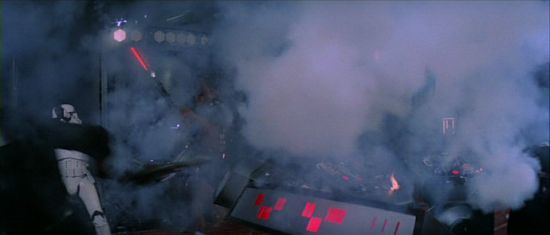
Imperial small-arms fire results in a room choked with smoke from vapourized metal
The power of this gun is nearly as difficult to quantify as its range, but we've seen that it has much more knock-down power than a modern SMG or even a carbine. It can heat stormtrooper chest-plate armour to red-hot, it can blast grapefruit-sized chunks out of the Bespin walls and small pockmarks out of Death Star bulkheads, and it can even kill a man with the explosive shockwave from a near-miss. This latter capability indicates high-velocity fragmentation from the explosive power of the impact, and it was demonstrated twice in ANH: once during the Death Star detention centre break-in, when an officer was killed by a hit to the wall behind him, and once during the "Tarzan scene", when Leia fired at a stormtrooper on the upper level, hit the wall directly behind his head, and killed him with the resulting shrapnel (it must have pierced the large flexible rubber section just beneath the back of his helmet). However, it can't penetrate the armour of Death Star blast doors or the forcefields used in Death Star garbage compactors. The explosive power of a blaster rifle shot may explain the utility of stormtrooper armour; like modern infantry body armour, it protects against shrapnel and glancing hits (unless they happen to hit a flexible joint area), but it can't stop a direct hit.
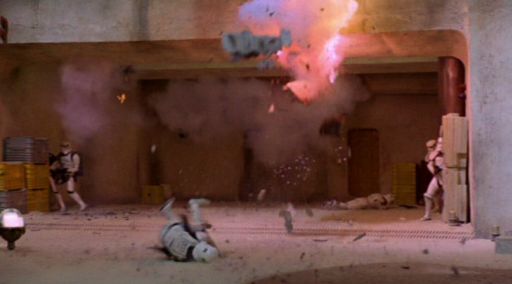
Docking
Bay 94 is damaged by Han Solo's blaster shots
The official literature provides more detailed information on range, for whatever it's worth: the SWEGWT states that the effective range of a Blastech E-11 is 100 metres with a maximum range of 300 metres (presumably when the stock is extended), which means that its range and accuracy are more like a carbine than a normal SMG. It also confirms that the weapon can be fired in fully automatic mode, but it points out that "extended automatic fire may throw the barrel out of alignment", which suggests that it is not meant for sustained automatic fire, again just like modern SMGs and carbines. Weapons like this are intended for either semi-automatic use at a distance, or short bursts of automatic fire at close range. And finally, it states that the standard power pack carries 100 shots, giving it much better ammunition capacity than modern SMGs or carbines. A man with a loaded Blastech E-11 and a dozen ammo clips would be able to fire 1300 shots before running dry.
There are those who would argue that 100-300 metre ranges are insufficient, but there is little or no justification for this idea. Combat scenarios in the Empire resemble anti-terrorist or police work much more than theoretical pitched battles over flat, open ground. In Star Wars, the Empire controls the galaxy and is opposed only by Rebel insurgents who have adopted classic guerilla tactics. The vast majority of stormtroopers function as guards, paramilitary police forces, or Spec Ops forces. In this sort of environment, an SMG or carbine is the ideal weapon. It is lightweight, convenient, inexpensive, and lethal at the sort of ranges they are likely to encounter. The Blastech E-11 even incorporates a stun mode, which is a useful feature for anti-terrorism or police work.
If you disagree, then consider the activities undertaken by stormtroopers in the films: they boarded a Rebel cruiser (close-quarters corridor fighting), they were guards on the Death Star (close-quarters corridor fighting), they debarked from AT-ATs into Echo Base on Hoth (close-quarters corridor fighting), they seized control of a criminal installation at Bespin (police work), they were guards on the Endor sanctuary moon (dense jungle fighting), and they were keeping the peace during the ROTJ-ending Coruscant celebration (police work). All of those activities would be appropriate for an SMG in real life, and in many of those activities (all those involving corridor combat), the length of an assault rifle would arguably just get in their way. The only time they deployed in flat, open ground was on the deserts of Tatooine in ANH, and the troopers on that particular "black ops" mission carried long-barreled rifles rather than their regular sidearms. For the vast majority of their regular work, a weapon like the Blastech E-11 fits the requirements perfectly.
As an aside, many have expressed interest in the mechanism of the Blastech E-11 stun beam. While Federation phasers simply lower their power levels for their "stun" setting (which is still destructive to the central nervous system and can even be lethal at short range, as demonstrated in ST6), Blastech E11 stun shots look much different than normal blaster bolts, thus suggesting a completely different operating mechanism. Instead of a red bolt, the stun blast is a small blue ring (it looked like it was rapidly expanding in ANH because it was headed directly towards the camera, thus appearing to grow as a result of perspective). The effect of this ring may be similar to a laser-ionization electroschock stun weapon currently under development in real life, which uses two laser beams to ionize a path between the gun and the target, and then uses the ionized path to close a high voltage electrical circuit through the target body. An Imperial blaster on "stun" might function similarly, by firing two beams: one core beam and one collinear annular beam (the ring), and then creating a large voltage potential between the two beams. If true, this would mean that the gun probably uses its "trigger laser" (described in SWEGWT as the blaster reaction initiator), splits it in two, and then applies a large voltage potential between the resulting pair of beams.
Assault Rifles
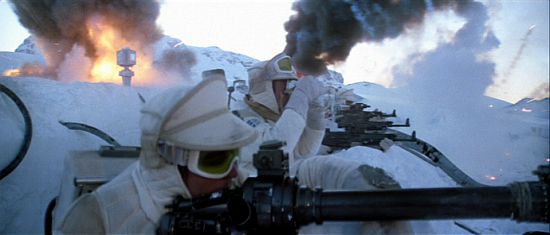
The
Rebel defense line at Hoth. Notice the large-barreled weapon in the
foreground
(possibly a GPMG) and the assault rifles used by the
other men in the background.
Since these weapons are designed for combat at medium to long range over open ground, their Imperial equivalents were rarely seen in the canon films. Most canon combat took place in a close quarters combat environment such as a building, a ship, or a jungle. However, when long-ranged weapons were appropriate, they were generally used. The picture at the top of this page shows stormtroopers on Tatooine, which is a desert environment where long-range sniping is a realistic possibility. What are they armed with? Naturally, they have large, long-barreled weapons rather than short Blastech E11 carbines. The stormtrooper in the foreground is carrying a Blastech T-21, which is actually a light machine gun rather than an assault rifle. The thick lagged barrel has cooling systems and focusing coils in order to increase its rate of fire and accuracy. The SWEGWT claims that the weapon can easily punch through armour, and that would be consistent with the heavy damage that the small stormtrooper team caused to the huge Jawa sandcrawler in ANH. According to the novelization:
"But I never heard of them hitting something this big." He leaned back, staring up at the towering, burned-out hulk of the sandcrawler.
...
Leaving Luke to gape at the parallel sets of tracks, Kenobi turned his attention to the sandcrawler. He pointed out where single weapons' bursts had blasted away portals, treads, and support beams.
In other words, single pinpoint shots destroyed entire support beams, and the support beams necessary for a vehicle of such great size would have to be enormously thick and strong. Even the act of destroying the huge treads alone would require heavy firepower; a modern soldier would be hard-pressed to do that kind of damage even with direct hits from a LAW or RPG. These men had no armoured vehicles; they were a "black ops" team, using dewbacks for mobility. The only weapons they had were the guns we saw them carrying, and with those guns, they were able to destroy a vehicle the size of a small apartment building.
Another canon situation which called for long-ranged weapons was the Battle of Hoth, in which the Rebel defense line attempted to engage Imperial walkers which were still many kilometres away. In their ill-fated effort to stop the Imperial ground assault, they used a combination of artillery (DF9 gun turrets, as well as the dish-like P-Tower cannons), tripod-mounted heavy automatic weapons, and the long-barreled weapons shown at the top of this section. This is exactly the sort of combination favoured by modern infantries for combat over open ground. Unfortunately for the Rebels, the Imperial attack consisted mostly of massive, heavily armoured AT-ATs that easily shrugged off their artillery fire (never mind their small-arms fire). However, against infantry or light vehicles the rebel defense weapons would have been a deadly combination. If you watch tbe Battle of Hoth you may notice that the AT-ATs reached the Rebel defense lines before the fleet-footed AT-STs. You may even notice that when the AT-ATs reach the Rebel defense lines, the AT-STs are nowhere in sight! Some of them may have been destroyed by Rebel defensive fire, since some of the Rebel weaponry was undoubtedly powerful to penetrate their thin armour. However, it's also possible that they diverted to the Rebel rear areas once it was obvious that the Rebel front lines were routed and they were no longer necessary to guard the AT-AT flanks.
 In
any case, although we saw these weapons being used, we didn't see
enough to ascertain their firepower or range with certainty. However,
their sheer length obviously implies superior range when compared to
the stubby Blastech E11s, and they were shooting at walkers which
were still at least 5-10 kilometres away. They also had stronger
recoil than the Blastech E11s which suggests that they fired more
powerful shots. Therefore, it would seem that their weapons have
effective range at least as good as that of modern assault rifles
(even after you compensate for the enormous size of a walker, which
will make it easier to hit from long distances), as well as greater
penetration than the Blastech E-11s. It is always possible
that its range and accuracy might be even greater than that of a
modern assault rifle, but that's entirely academic because the
limiting factor at such range is the soldier rather than the gun
itself.
In
any case, although we saw these weapons being used, we didn't see
enough to ascertain their firepower or range with certainty. However,
their sheer length obviously implies superior range when compared to
the stubby Blastech E11s, and they were shooting at walkers which
were still at least 5-10 kilometres away. They also had stronger
recoil than the Blastech E11s which suggests that they fired more
powerful shots. Therefore, it would seem that their weapons have
effective range at least as good as that of modern assault rifles
(even after you compensate for the enormous size of a walker, which
will make it easier to hit from long distances), as well as greater
penetration than the Blastech E-11s. It is always possible
that its range and accuracy might be even greater than that of a
modern assault rifle, but that's entirely academic because the
limiting factor at such range is the soldier rather than the gun
itself.
There are strong WW1 influences in the Battle of Hoth; the multi-kilometre range of their infantry weaponry is similar to the (unnecessarily long) multi-kilometre range of WW1-era machine guns, which overlaps into the ranges normally reserved for artillery. The trench warfare is strongly reminiscent of WW1. The heavily armoured, lumbering AT-ATs are obviously reminiscent of WW1 tanks. The huge barrels of the Rebel heavy automatic weapons are strongly reminiscent of Hiram Maxim's early water-cooled machine gun barrel designs. Also notice the array of small guns on the AT-AT head as opposed to a single huge gun, which is also reminiscent of WW1 tanks since they were designed for breaching defense lines rather than fighting other tanks.
Yet another long-barreled gun design in the canon films was Han Solo's captured Imperial blaster rifle (above right). This one is bulkier than either the Rebel or Imperial assault rifles mentioned earlier, but it's not as bulky as their heavy automatic weapons. It may be a light automatic weapon, but it's difficult to tell for sure.
Sniper Rifles
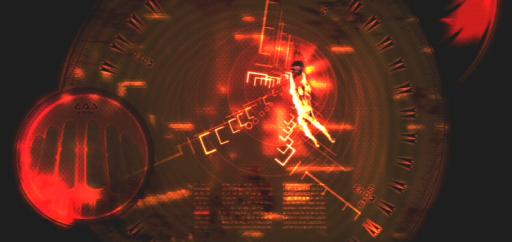
Obi-Wan
Kenobi viewed through Zam Wessel's sniper rifle scope
Zam Wessel's sniper rifle in AOTC is the most well-known canon example of such a weapon in Star Wars. It incorporated some kind of electronic scope with active target tracking and highlighting, and she was able to score a direct hit on the assassin droid (thus plunging Kenobi into free-fall). However, the most powerful long-range rifle is probably the heavy clonetrooper rifle. These weapons were used to blow droidekas in half on the arena floor from close range, and to destroy battledroids and superbattledroids at extreme range over open ground.
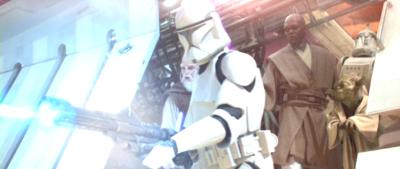
A
clonetrooper firing his weapon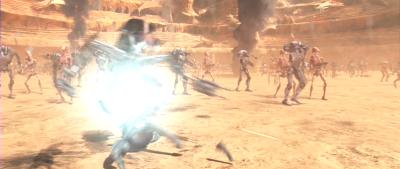
A
droideka being blown in half by the bolt
Clonetrooper rifles are large, heavy, and unwieldy. This would make them unsuitable for operations in urban areas or starship boarding operations (for example), but in the wide-open spaces of the Geonosian plains battle, their great range and firepower were absolutely necessary. Just as modern heavy sniper rifles are characterized both by their accuracy and their punch, clonetrooper rifles are both destructive and combat-effective at very long range.
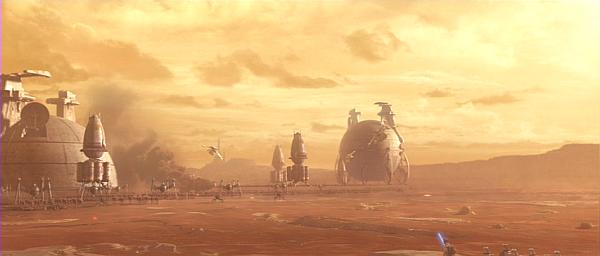
The
battlefield at Geonosis (notice the 700m wide TradeFed spheres for
scale)
Of course, other long rifles have been sighted in the films, such as IG-88's Blastech DLT-20A or Han Solo's captured rifle (in ANH). But their capabilities were never demonstrated as clearly as those of the clonetrooper rifles at Geonosis.
Machine Guns
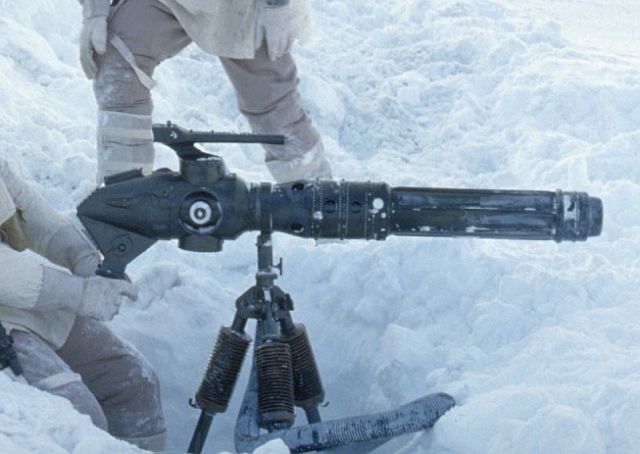
A Rebel cable-fed tripod-mounted HMG at Hoth
This category is most popularly represented by the E-Web, which was seen in the Echo Base hangar as a group of "snowtroopers" attempted to set it up prior to attacking the Millenium Falcon. Some of the apocryphal literature describes extremely long setup times (anywhere from 5 minutes to 15 minutes) for this weapon, but those setup times seem ridiculously exaggerated in light of the fact that the snowtroopers were trying to set it up and use it on the Falcon before it could escape. Real-life GPMGs are designed for maximum ease of use and setup (a competent crew can set one up in less than 2 minutes), and there is no conceivable reason that the designers of the E-Web would have thought any differently. You can see evidence of the E-Web's true setup time if you simply watch this scene carefully: just before Han Solo fires a burst from the Falcon's drop-down automatic weapon (roughly analogous to the .50 calibre machine gun commonly mounted on modern infantry combat vehicle), it looks like one of the snowtroopers is already getting ready to fire the weapon! The reason for the grossly exaggerated setup time is probably due to the well-established New Republic bias in the official literature.
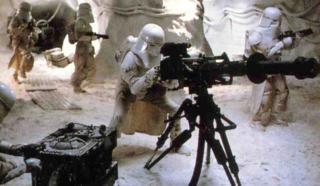 In
any case, the E-Web is analogous to a very heavy machine gun, even
larger than the wide-barreled automatic weapon the Rebels used in
their futile defense effort. It expends power at such a prodigious
rate that it requires a dedicated crate-sized power generator (see
picture at right), which is an ominous sign considering how
destructive their relatively tiny handguns and blaster rifles already
are. Any group of infantry caught in open ground through the sights
of this weapon would surely be blown to steaming bits in seconds, and
the weapon seems to have light armour-piercing capability as well,
since the snowtroopers intended to penetrate the Falcon's hull with
it. A weapon like this can dominate a battlefield if properly
positioned, as demonstrated in real life by the carnage German
machine gun emplacements inflicted on British, Canadian and American
forces as they pushed ashore on D-Day.
In
any case, the E-Web is analogous to a very heavy machine gun, even
larger than the wide-barreled automatic weapon the Rebels used in
their futile defense effort. It expends power at such a prodigious
rate that it requires a dedicated crate-sized power generator (see
picture at right), which is an ominous sign considering how
destructive their relatively tiny handguns and blaster rifles already
are. Any group of infantry caught in open ground through the sights
of this weapon would surely be blown to steaming bits in seconds, and
the weapon seems to have light armour-piercing capability as well,
since the snowtroopers intended to penetrate the Falcon's hull with
it. A weapon like this can dominate a battlefield if properly
positioned, as demonstrated in real life by the carnage German
machine gun emplacements inflicted on British, Canadian and American
forces as they pushed ashore on D-Day.
You may notice the large sighting attachments on both the Rebel HMG and the Imperial HMG. Both of them appear to incorporate some sort of powered scope, but unfortunately, the films never showed us the view through either device, so we have no way of knowing what sort of information is being conveyed. At an absolute minimum, I would expect that the information is equal to what a pair of electrobinoculars would provide. Since these weapons are apparently capable of multi-kilometre ranges (given the ranges at which they were used in the Battle of Hoth), the scopes make sense, and I would presume that there is some sort of internal scope adjustment mechanism.
Of course, very large HMGs like the dreaded E-Web are not the only machine guns in the Empire. The Blastech T-21 (seen in the hands of the foreground stormtrooper in the picture at the top of this page) is described by the SWEGWT as a "common support weapon for army and stormtrooper squads", precisely as expected for a GPMG. Its power pack (ie- ammo clip) only has 25 shots, but the gun can also be hooked up to a 20 kg backpack generator (analogous to a box of belt-feed ammunition for a machine gun) that can feed it "potentially unlimited fire capability". The weapon has light anti-armour capability, and is said to be capable of blasting through armour suits, force fields and even the hull plating of armoured landspeeders.
Conclusion
The Empire equips its soldiers with a combination of handguns, carbines, assault rifles, and both light and heavy machine guns, just like a real army. In short, this means that they can utilize all of the tactics used by real soldiers, without having to work around gaping holes in their armament catalogue the way Federation soldiers do.